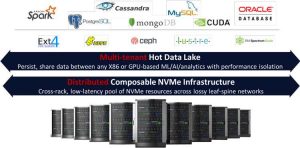FMS: Attala Showcased Cross-Rack Scalability for NVMe over Fabric Composable Storage Infrastructure
Solution developed with Mellanox to extend the reach of NVMe-oRoCE networks with ordinary NICs and across lossy layer 3 leaf-spine networks
This is a Press Release edited by StorageNewsletter.com on August 14, 2018 at 2:20 pmAttala Systems, Inc. showcased its implementation for cross-rack, lossy networks at the 2018 Flash Memory Summit.
The company’s approach provides a way to utilize RoCE’s speed and low latency without the issues that have historically plagued its ability to be deployed on large-scale networks. The solution was developed with Mellanox Technologies Ltd. as a way to extend the reach of NVMe over RoCE (NVMe-oRoCE) networks with ordinary NICs and across lossy Layer 3 (L3) leaf-spine networks.
One of the most troublesome issues with RoCE-based protocols has been the need for the underlying networks to be lossless. While this is relatively easy for rack-scale deployments, it has historically been difficult to achieve on conventional layer three (L3) leaf-spine networks. By hardening the open-source SoftRoCE initiator, the firm’s own devices and providing SSDP-based discovery, the company has enabled its RoCE-based networking capability to operate on standard leaf-spine networks and with ordinary NICs. This allows cross-rack and ubiquitous deployment of NVMe-oRoCE’s low latency and performance on Ethernet networks at speeds from 10GbE to 100GbE and beyond.
“NVMe over RoCE has always been seen as the lowest latency, highest performance flavor of NVMe protocols. However, NVMe over RoCE’s need for lossless networks and specialized initiators has been somewhat of a limitation to its deployment,” said Taufik Ma, CEO, Attala. “Attala Systems’ approach allows their solution to be deployed on standard L3 leaf-spine networks without any special considerations.“
The cross-rack scalability of the company’s solution is enabled by hardening the open-source SoftRoCE initiator driver and its own devices to gracefully handle packet-drops in a L3 leaf-spine networks – even those which do not support priority flow control (PFC) for achieve losslessness. This unshackles NVMe-over-RoCE solutions from the confines of a single rack and specific servers. The firm’s solution also includes an autonomous Simple Service Discovery Protocol (SSDP) based discovery mechanism for newly added end-points, solving a common issue experienced by IP networks being utilized for scale-out infrastructure deployments. The community-hardened open-source SoftRoCE initiator driver runs on any ordinary NIC, enabling 100% compatibility with any Linux-based host server across the data center.














 Subscribe to our free daily newsletter
Subscribe to our free daily newsletter

